ECU NCS6102: Case Study on Acute Pyelonephritis Nursing Management
VerifiedAdded on 2023/06/07
|7
|1618
|138
Case Study
AI Summary
This case study focuses on a 27-year-old woman, Miss Adele, diagnosed with acute pyelonephritis, a severe kidney infection often caused by E. coli. The assignment delves into the etiology, pathophysiology, and clinical manifestations of the condition, including the role of the urinary tract and bacterial infection. It outlines essential diagnostic investigations such as urinalysis, blood cultures, and imaging tests to evaluate the patient's condition and potential kidney damage. Furthermore, the case study details comprehensive nursing care, emphasizing the four ADLs, including toileting, dressing, drinking and bathing, along with pharmacological treatments like antibiotics (Ciprofloxacin and Levofloxacin), and their potential side effects. The case study concludes by highlighting the curability of pyelonephritis with proper medication and nursing care and the importance of preventing future kidney complications.

Running head: CASE STUDY ON NURSING
Student Name:
Student Number:
Date of Submission:
Word Count:
Student Name:
Student Number:
Date of Submission:
Word Count:
Paraphrase This Document
Need a fresh take? Get an instant paraphrase of this document with our AI Paraphraser
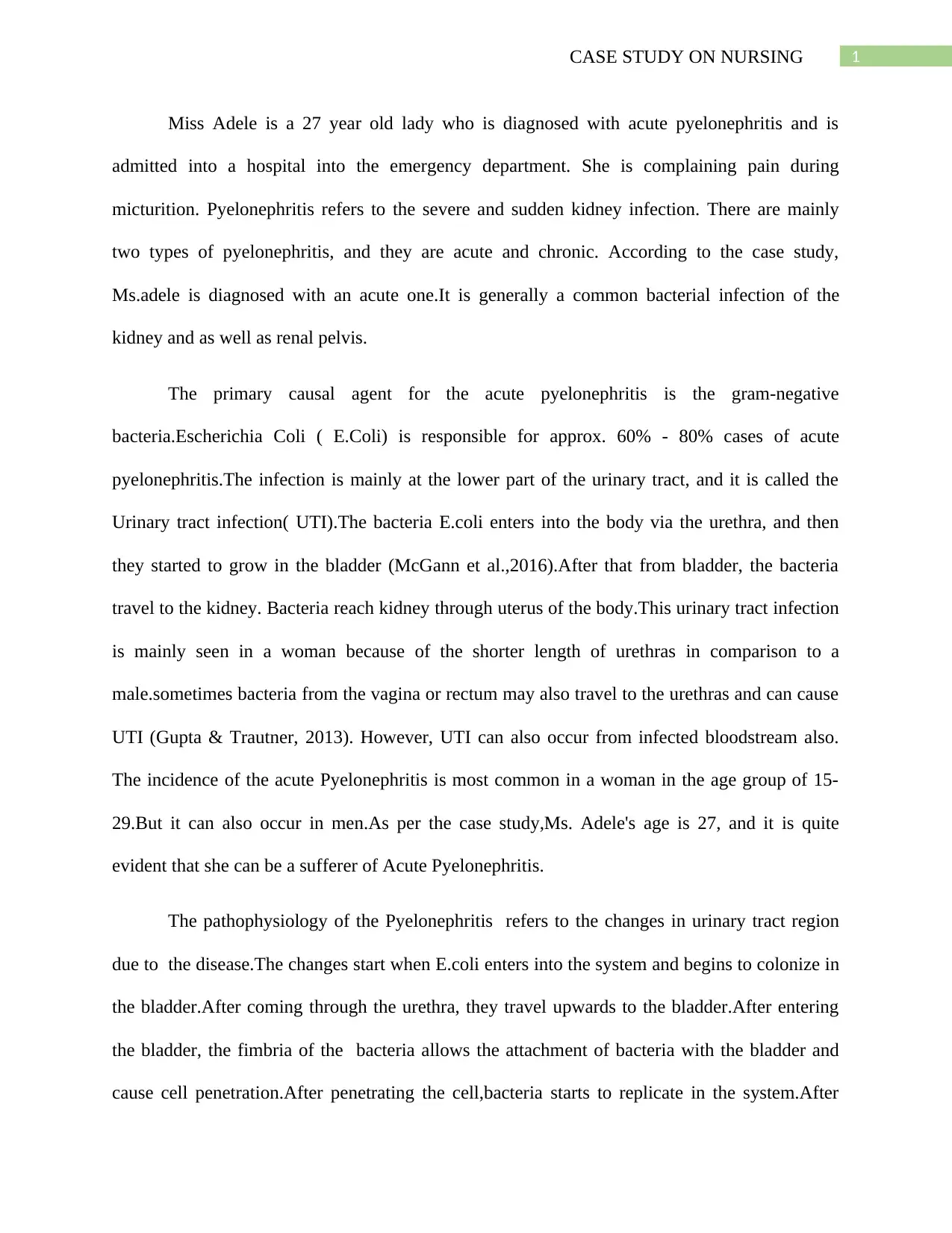
1CASE STUDY ON NURSING
Miss Adele is a 27 year old lady who is diagnosed with acute pyelonephritis and is
admitted into a hospital into the emergency department. She is complaining pain during
micturition. Pyelonephritis refers to the severe and sudden kidney infection. There are mainly
two types of pyelonephritis, and they are acute and chronic. According to the case study,
Ms.adele is diagnosed with an acute one.It is generally a common bacterial infection of the
kidney and as well as renal pelvis.
The primary causal agent for the acute pyelonephritis is the gram-negative
bacteria.Escherichia Coli ( E.Coli) is responsible for approx. 60% - 80% cases of acute
pyelonephritis.The infection is mainly at the lower part of the urinary tract, and it is called the
Urinary tract infection( UTI).The bacteria E.coli enters into the body via the urethra, and then
they started to grow in the bladder (McGann et al.,2016).After that from bladder, the bacteria
travel to the kidney. Bacteria reach kidney through uterus of the body.This urinary tract infection
is mainly seen in a woman because of the shorter length of urethras in comparison to a
male.sometimes bacteria from the vagina or rectum may also travel to the urethras and can cause
UTI (Gupta & Trautner, 2013). However, UTI can also occur from infected bloodstream also.
The incidence of the acute Pyelonephritis is most common in a woman in the age group of 15-
29.But it can also occur in men.As per the case study,Ms. Adele's age is 27, and it is quite
evident that she can be a sufferer of Acute Pyelonephritis.
The pathophysiology of the Pyelonephritis refers to the changes in urinary tract region
due to the disease.The changes start when E.coli enters into the system and begins to colonize in
the bladder.After coming through the urethra, they travel upwards to the bladder.After entering
the bladder, the fimbria of the bacteria allows the attachment of bacteria with the bladder and
cause cell penetration.After penetrating the cell,bacteria starts to replicate in the system.After
Miss Adele is a 27 year old lady who is diagnosed with acute pyelonephritis and is
admitted into a hospital into the emergency department. She is complaining pain during
micturition. Pyelonephritis refers to the severe and sudden kidney infection. There are mainly
two types of pyelonephritis, and they are acute and chronic. According to the case study,
Ms.adele is diagnosed with an acute one.It is generally a common bacterial infection of the
kidney and as well as renal pelvis.
The primary causal agent for the acute pyelonephritis is the gram-negative
bacteria.Escherichia Coli ( E.Coli) is responsible for approx. 60% - 80% cases of acute
pyelonephritis.The infection is mainly at the lower part of the urinary tract, and it is called the
Urinary tract infection( UTI).The bacteria E.coli enters into the body via the urethra, and then
they started to grow in the bladder (McGann et al.,2016).After that from bladder, the bacteria
travel to the kidney. Bacteria reach kidney through uterus of the body.This urinary tract infection
is mainly seen in a woman because of the shorter length of urethras in comparison to a
male.sometimes bacteria from the vagina or rectum may also travel to the urethras and can cause
UTI (Gupta & Trautner, 2013). However, UTI can also occur from infected bloodstream also.
The incidence of the acute Pyelonephritis is most common in a woman in the age group of 15-
29.But it can also occur in men.As per the case study,Ms. Adele's age is 27, and it is quite
evident that she can be a sufferer of Acute Pyelonephritis.
The pathophysiology of the Pyelonephritis refers to the changes in urinary tract region
due to the disease.The changes start when E.coli enters into the system and begins to colonize in
the bladder.After coming through the urethra, they travel upwards to the bladder.After entering
the bladder, the fimbria of the bacteria allows the attachment of bacteria with the bladder and
cause cell penetration.After penetrating the cell,bacteria starts to replicate in the system.After
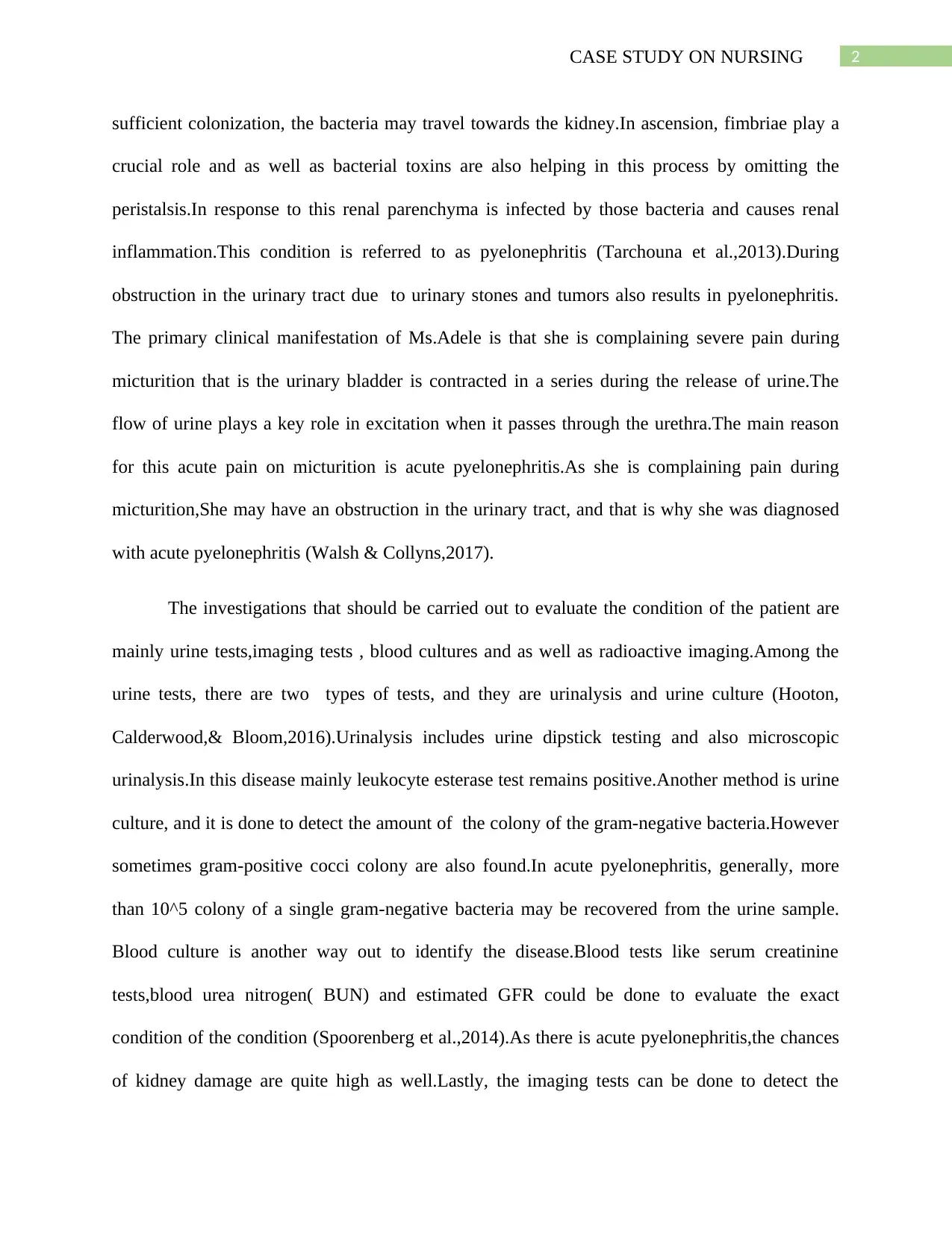
2CASE STUDY ON NURSING
sufficient colonization, the bacteria may travel towards the kidney.In ascension, fimbriae play a
crucial role and as well as bacterial toxins are also helping in this process by omitting the
peristalsis.In response to this renal parenchyma is infected by those bacteria and causes renal
inflammation.This condition is referred to as pyelonephritis (Tarchouna et al.,2013).During
obstruction in the urinary tract due to urinary stones and tumors also results in pyelonephritis.
The primary clinical manifestation of Ms.Adele is that she is complaining severe pain during
micturition that is the urinary bladder is contracted in a series during the release of urine.The
flow of urine plays a key role in excitation when it passes through the urethra.The main reason
for this acute pain on micturition is acute pyelonephritis.As she is complaining pain during
micturition,She may have an obstruction in the urinary tract, and that is why she was diagnosed
with acute pyelonephritis (Walsh & Collyns,2017).
The investigations that should be carried out to evaluate the condition of the patient are
mainly urine tests,imaging tests , blood cultures and as well as radioactive imaging.Among the
urine tests, there are two types of tests, and they are urinalysis and urine culture (Hooton,
Calderwood,& Bloom,2016).Urinalysis includes urine dipstick testing and also microscopic
urinalysis.In this disease mainly leukocyte esterase test remains positive.Another method is urine
culture, and it is done to detect the amount of the colony of the gram-negative bacteria.However
sometimes gram-positive cocci colony are also found.In acute pyelonephritis, generally, more
than 10^5 colony of a single gram-negative bacteria may be recovered from the urine sample.
Blood culture is another way out to identify the disease.Blood tests like serum creatinine
tests,blood urea nitrogen( BUN) and estimated GFR could be done to evaluate the exact
condition of the condition (Spoorenberg et al.,2014).As there is acute pyelonephritis,the chances
of kidney damage are quite high as well.Lastly, the imaging tests can be done to detect the
sufficient colonization, the bacteria may travel towards the kidney.In ascension, fimbriae play a
crucial role and as well as bacterial toxins are also helping in this process by omitting the
peristalsis.In response to this renal parenchyma is infected by those bacteria and causes renal
inflammation.This condition is referred to as pyelonephritis (Tarchouna et al.,2013).During
obstruction in the urinary tract due to urinary stones and tumors also results in pyelonephritis.
The primary clinical manifestation of Ms.Adele is that she is complaining severe pain during
micturition that is the urinary bladder is contracted in a series during the release of urine.The
flow of urine plays a key role in excitation when it passes through the urethra.The main reason
for this acute pain on micturition is acute pyelonephritis.As she is complaining pain during
micturition,She may have an obstruction in the urinary tract, and that is why she was diagnosed
with acute pyelonephritis (Walsh & Collyns,2017).
The investigations that should be carried out to evaluate the condition of the patient are
mainly urine tests,imaging tests , blood cultures and as well as radioactive imaging.Among the
urine tests, there are two types of tests, and they are urinalysis and urine culture (Hooton,
Calderwood,& Bloom,2016).Urinalysis includes urine dipstick testing and also microscopic
urinalysis.In this disease mainly leukocyte esterase test remains positive.Another method is urine
culture, and it is done to detect the amount of the colony of the gram-negative bacteria.However
sometimes gram-positive cocci colony are also found.In acute pyelonephritis, generally, more
than 10^5 colony of a single gram-negative bacteria may be recovered from the urine sample.
Blood culture is another way out to identify the disease.Blood tests like serum creatinine
tests,blood urea nitrogen( BUN) and estimated GFR could be done to evaluate the exact
condition of the condition (Spoorenberg et al.,2014).As there is acute pyelonephritis,the chances
of kidney damage are quite high as well.Lastly, the imaging tests can be done to detect the
⊘ This is a preview!⊘
Do you want full access?
Subscribe today to unlock all pages.

Trusted by 1+ million students worldwide
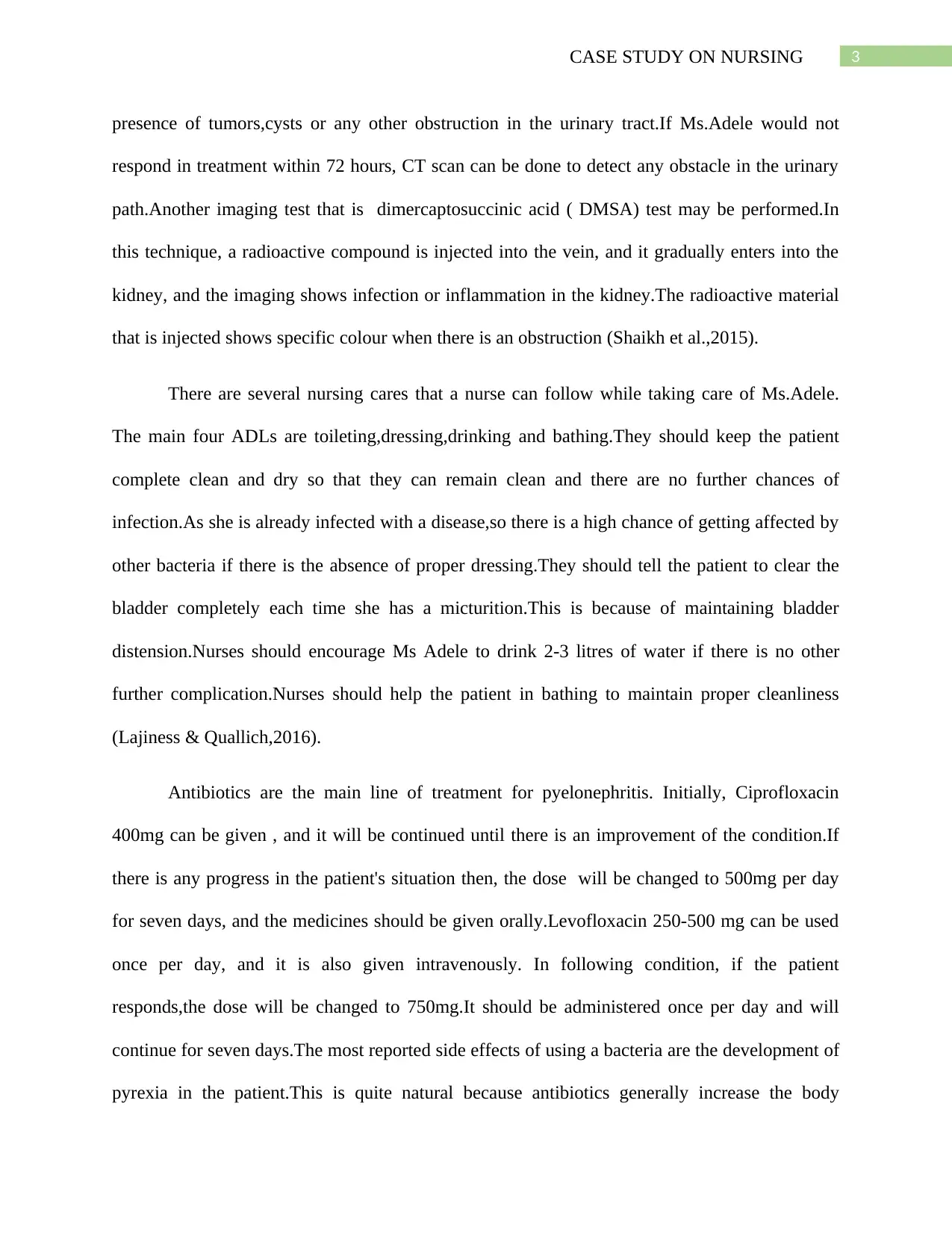
3CASE STUDY ON NURSING
presence of tumors,cysts or any other obstruction in the urinary tract.If Ms.Adele would not
respond in treatment within 72 hours, CT scan can be done to detect any obstacle in the urinary
path.Another imaging test that is dimercaptosuccinic acid ( DMSA) test may be performed.In
this technique, a radioactive compound is injected into the vein, and it gradually enters into the
kidney, and the imaging shows infection or inflammation in the kidney.The radioactive material
that is injected shows specific colour when there is an obstruction (Shaikh et al.,2015).
There are several nursing cares that a nurse can follow while taking care of Ms.Adele.
The main four ADLs are toileting,dressing,drinking and bathing.They should keep the patient
complete clean and dry so that they can remain clean and there are no further chances of
infection.As she is already infected with a disease,so there is a high chance of getting affected by
other bacteria if there is the absence of proper dressing.They should tell the patient to clear the
bladder completely each time she has a micturition.This is because of maintaining bladder
distension.Nurses should encourage Ms Adele to drink 2-3 litres of water if there is no other
further complication.Nurses should help the patient in bathing to maintain proper cleanliness
(Lajiness & Quallich,2016).
Antibiotics are the main line of treatment for pyelonephritis. Initially, Ciprofloxacin
400mg can be given , and it will be continued until there is an improvement of the condition.If
there is any progress in the patient's situation then, the dose will be changed to 500mg per day
for seven days, and the medicines should be given orally.Levofloxacin 250-500 mg can be used
once per day, and it is also given intravenously. In following condition, if the patient
responds,the dose will be changed to 750mg.It should be administered once per day and will
continue for seven days.The most reported side effects of using a bacteria are the development of
pyrexia in the patient.This is quite natural because antibiotics generally increase the body
presence of tumors,cysts or any other obstruction in the urinary tract.If Ms.Adele would not
respond in treatment within 72 hours, CT scan can be done to detect any obstacle in the urinary
path.Another imaging test that is dimercaptosuccinic acid ( DMSA) test may be performed.In
this technique, a radioactive compound is injected into the vein, and it gradually enters into the
kidney, and the imaging shows infection or inflammation in the kidney.The radioactive material
that is injected shows specific colour when there is an obstruction (Shaikh et al.,2015).
There are several nursing cares that a nurse can follow while taking care of Ms.Adele.
The main four ADLs are toileting,dressing,drinking and bathing.They should keep the patient
complete clean and dry so that they can remain clean and there are no further chances of
infection.As she is already infected with a disease,so there is a high chance of getting affected by
other bacteria if there is the absence of proper dressing.They should tell the patient to clear the
bladder completely each time she has a micturition.This is because of maintaining bladder
distension.Nurses should encourage Ms Adele to drink 2-3 litres of water if there is no other
further complication.Nurses should help the patient in bathing to maintain proper cleanliness
(Lajiness & Quallich,2016).
Antibiotics are the main line of treatment for pyelonephritis. Initially, Ciprofloxacin
400mg can be given , and it will be continued until there is an improvement of the condition.If
there is any progress in the patient's situation then, the dose will be changed to 500mg per day
for seven days, and the medicines should be given orally.Levofloxacin 250-500 mg can be used
once per day, and it is also given intravenously. In following condition, if the patient
responds,the dose will be changed to 750mg.It should be administered once per day and will
continue for seven days.The most reported side effects of using a bacteria are the development of
pyrexia in the patient.This is quite natural because antibiotics generally increase the body
Paraphrase This Document
Need a fresh take? Get an instant paraphrase of this document with our AI Paraphraser
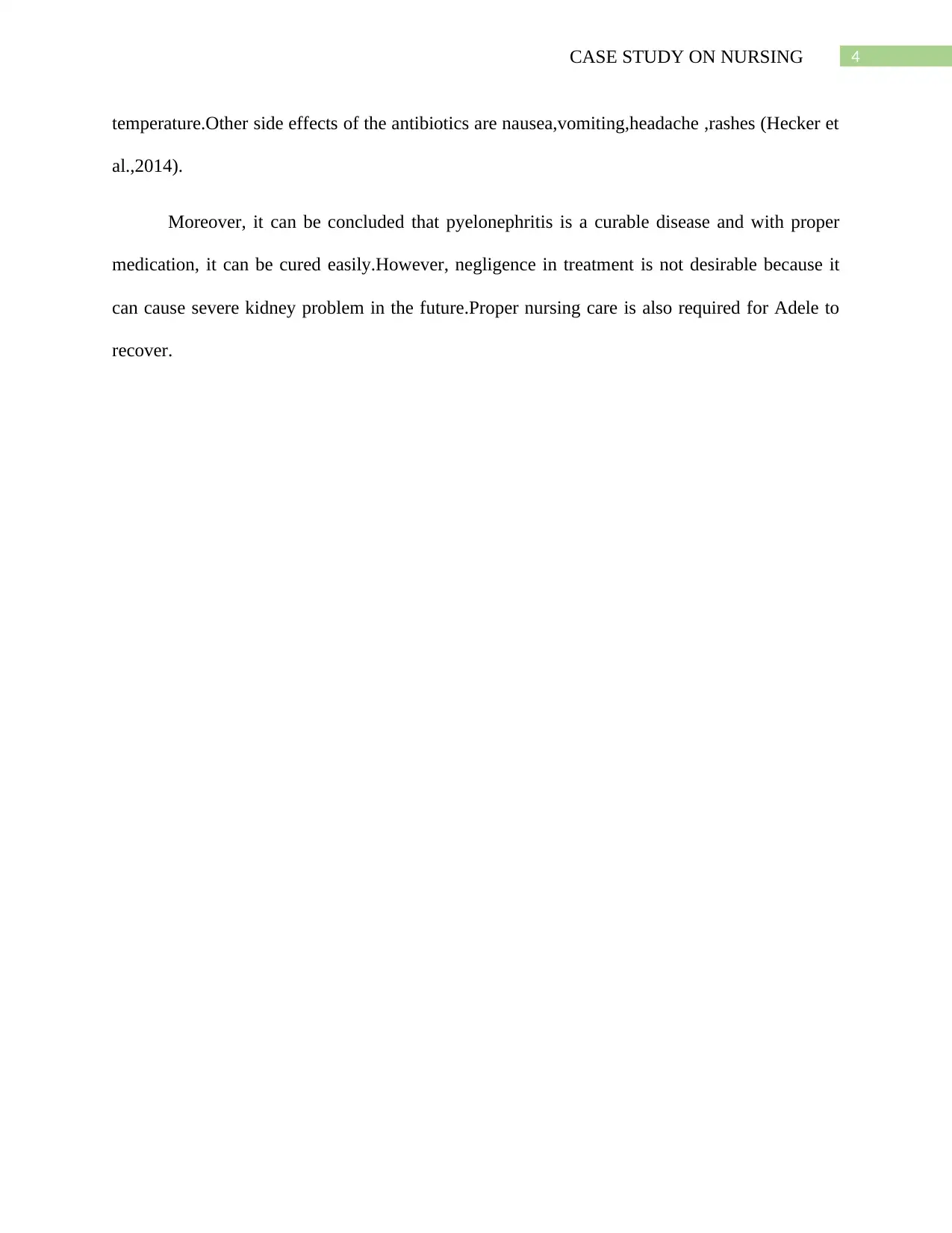
4CASE STUDY ON NURSING
temperature.Other side effects of the antibiotics are nausea,vomiting,headache ,rashes (Hecker et
al.,2014).
Moreover, it can be concluded that pyelonephritis is a curable disease and with proper
medication, it can be cured easily.However, negligence in treatment is not desirable because it
can cause severe kidney problem in the future.Proper nursing care is also required for Adele to
recover.
temperature.Other side effects of the antibiotics are nausea,vomiting,headache ,rashes (Hecker et
al.,2014).
Moreover, it can be concluded that pyelonephritis is a curable disease and with proper
medication, it can be cured easily.However, negligence in treatment is not desirable because it
can cause severe kidney problem in the future.Proper nursing care is also required for Adele to
recover.
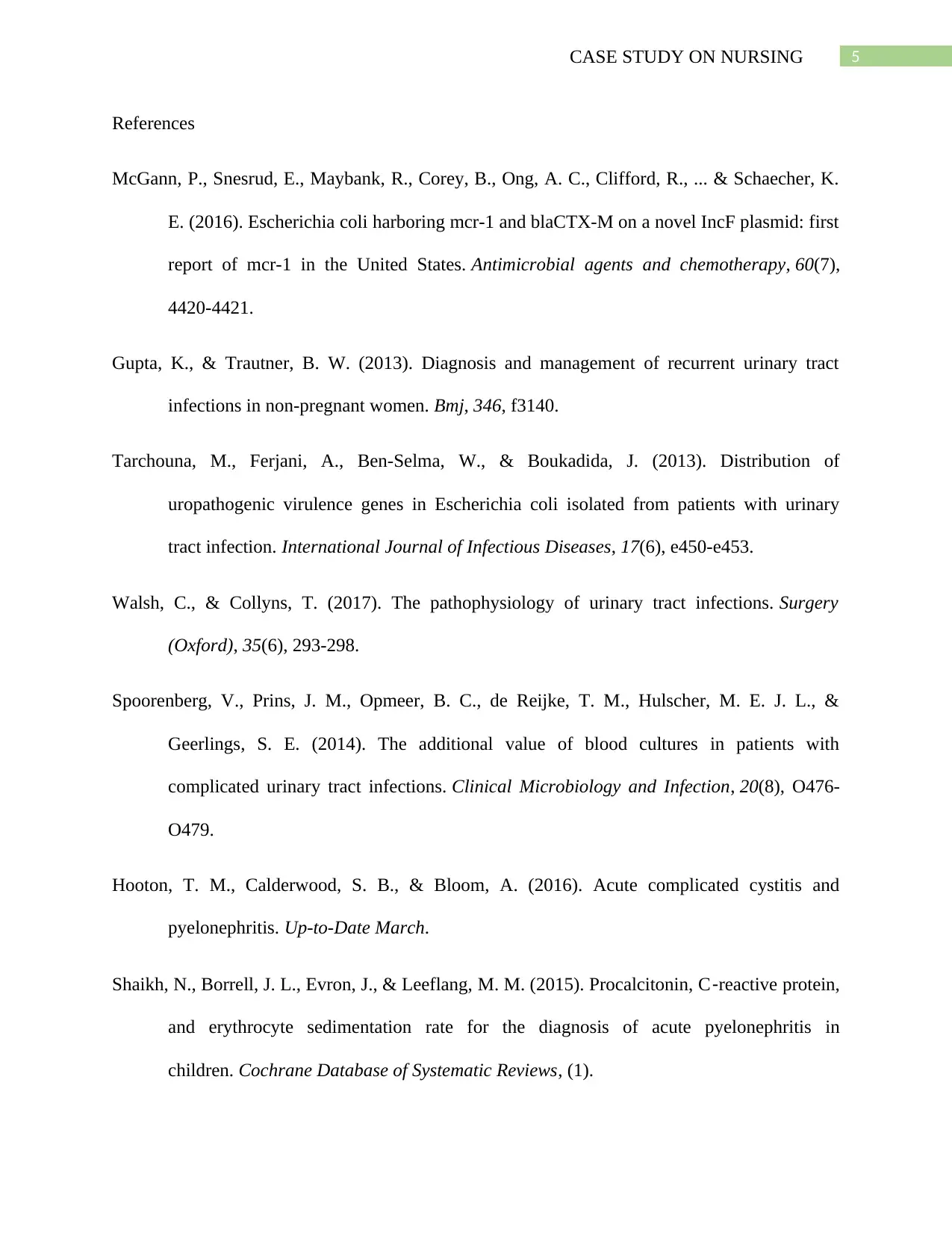
5CASE STUDY ON NURSING
References
McGann, P., Snesrud, E., Maybank, R., Corey, B., Ong, A. C., Clifford, R., ... & Schaecher, K.
E. (2016). Escherichia coli harboring mcr-1 and blaCTX-M on a novel IncF plasmid: first
report of mcr-1 in the United States. Antimicrobial agents and chemotherapy, 60(7),
4420-4421.
Gupta, K., & Trautner, B. W. (2013). Diagnosis and management of recurrent urinary tract
infections in non-pregnant women. Bmj, 346, f3140.
Tarchouna, M., Ferjani, A., Ben-Selma, W., & Boukadida, J. (2013). Distribution of
uropathogenic virulence genes in Escherichia coli isolated from patients with urinary
tract infection. International Journal of Infectious Diseases, 17(6), e450-e453.
Walsh, C., & Collyns, T. (2017). The pathophysiology of urinary tract infections. Surgery
(Oxford), 35(6), 293-298.
Spoorenberg, V., Prins, J. M., Opmeer, B. C., de Reijke, T. M., Hulscher, M. E. J. L., &
Geerlings, S. E. (2014). The additional value of blood cultures in patients with
complicated urinary tract infections. Clinical Microbiology and Infection, 20(8), O476-
O479.
Hooton, T. M., Calderwood, S. B., & Bloom, A. (2016). Acute complicated cystitis and
pyelonephritis. Up-to-Date March.
Shaikh, N., Borrell, J. L., Evron, J., & Leeflang, M. M. (2015). Procalcitonin, C‐reactive protein,
and erythrocyte sedimentation rate for the diagnosis of acute pyelonephritis in
children. Cochrane Database of Systematic Reviews, (1).
References
McGann, P., Snesrud, E., Maybank, R., Corey, B., Ong, A. C., Clifford, R., ... & Schaecher, K.
E. (2016). Escherichia coli harboring mcr-1 and blaCTX-M on a novel IncF plasmid: first
report of mcr-1 in the United States. Antimicrobial agents and chemotherapy, 60(7),
4420-4421.
Gupta, K., & Trautner, B. W. (2013). Diagnosis and management of recurrent urinary tract
infections in non-pregnant women. Bmj, 346, f3140.
Tarchouna, M., Ferjani, A., Ben-Selma, W., & Boukadida, J. (2013). Distribution of
uropathogenic virulence genes in Escherichia coli isolated from patients with urinary
tract infection. International Journal of Infectious Diseases, 17(6), e450-e453.
Walsh, C., & Collyns, T. (2017). The pathophysiology of urinary tract infections. Surgery
(Oxford), 35(6), 293-298.
Spoorenberg, V., Prins, J. M., Opmeer, B. C., de Reijke, T. M., Hulscher, M. E. J. L., &
Geerlings, S. E. (2014). The additional value of blood cultures in patients with
complicated urinary tract infections. Clinical Microbiology and Infection, 20(8), O476-
O479.
Hooton, T. M., Calderwood, S. B., & Bloom, A. (2016). Acute complicated cystitis and
pyelonephritis. Up-to-Date March.
Shaikh, N., Borrell, J. L., Evron, J., & Leeflang, M. M. (2015). Procalcitonin, C‐reactive protein,
and erythrocyte sedimentation rate for the diagnosis of acute pyelonephritis in
children. Cochrane Database of Systematic Reviews, (1).
⊘ This is a preview!⊘
Do you want full access?
Subscribe today to unlock all pages.

Trusted by 1+ million students worldwide
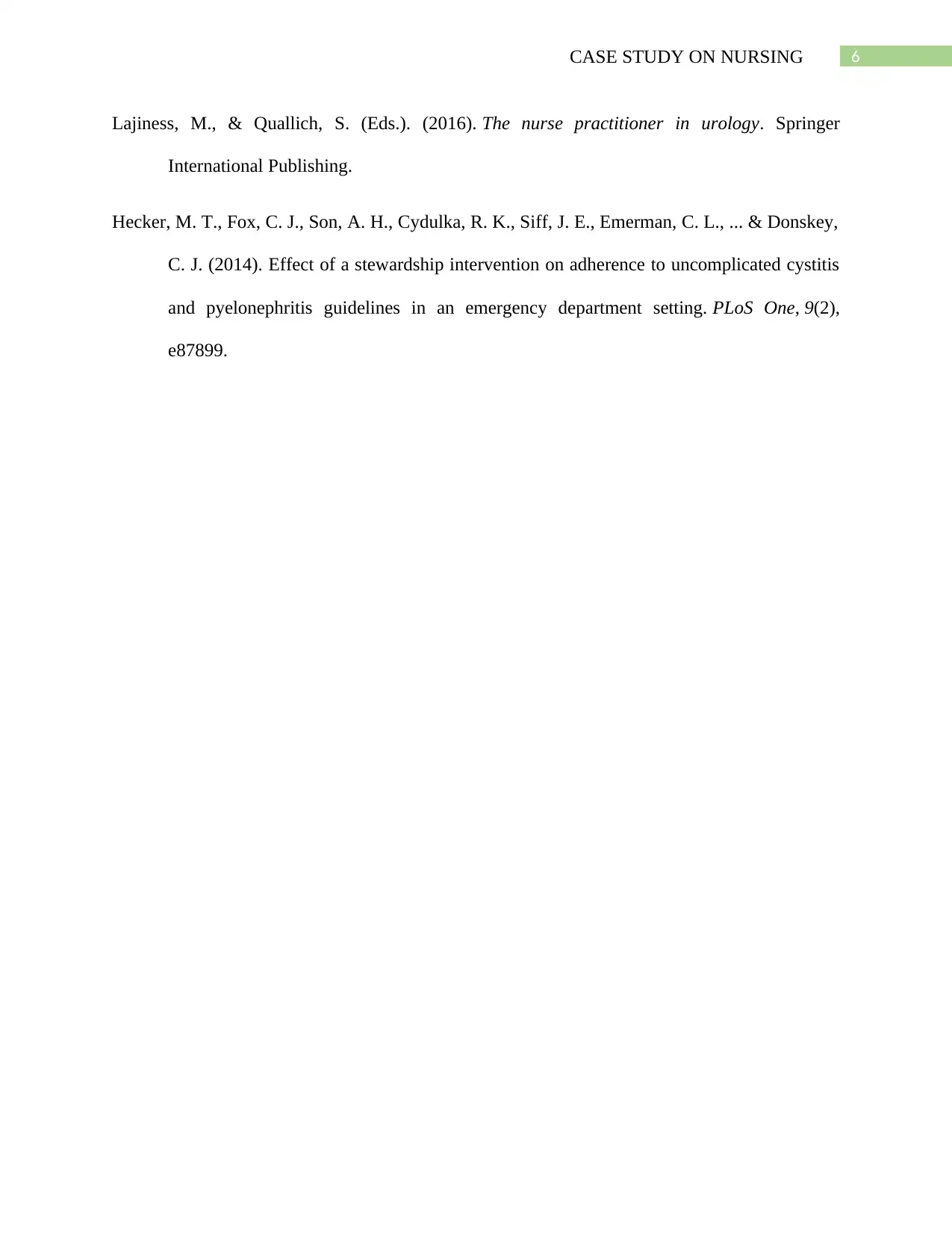
6CASE STUDY ON NURSING
Lajiness, M., & Quallich, S. (Eds.). (2016). The nurse practitioner in urology. Springer
International Publishing.
Hecker, M. T., Fox, C. J., Son, A. H., Cydulka, R. K., Siff, J. E., Emerman, C. L., ... & Donskey,
C. J. (2014). Effect of a stewardship intervention on adherence to uncomplicated cystitis
and pyelonephritis guidelines in an emergency department setting. PLoS One, 9(2),
e87899.
Lajiness, M., & Quallich, S. (Eds.). (2016). The nurse practitioner in urology. Springer
International Publishing.
Hecker, M. T., Fox, C. J., Son, A. H., Cydulka, R. K., Siff, J. E., Emerman, C. L., ... & Donskey,
C. J. (2014). Effect of a stewardship intervention on adherence to uncomplicated cystitis
and pyelonephritis guidelines in an emergency department setting. PLoS One, 9(2),
e87899.
1 out of 7
Related Documents
Your All-in-One AI-Powered Toolkit for Academic Success.
+13062052269
info@desklib.com
Available 24*7 on WhatsApp / Email
![[object Object]](/_next/static/media/star-bottom.7253800d.svg)
Unlock your academic potential
Copyright © 2020–2025 A2Z Services. All Rights Reserved. Developed and managed by ZUCOL.





